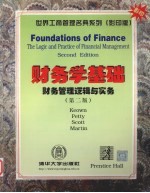图书介绍
财务学基础 财务管理逻辑与实务 英文版 第2版pdf电子书版本下载

- (美)Arthur J.Keown等著 著
- 出版社: 北京:清华大学出版社
- ISBN:7302030707
- 出版时间:1998
- 标注页数:552页
- 文件大小:252MB
- 文件页数:629页
- 主题词:财务管理实务
PDF下载
下载说明
财务学基础 财务管理逻辑与实务 英文版 第2版PDF格式电子书版下载
下载的文件为RAR压缩包。需要使用解压软件进行解压得到PDF格式图书。建议使用BT下载工具Free Download Manager进行下载,简称FDM(免费,没有广告,支持多平台)。本站资源全部打包为BT种子。所以需要使用专业的BT下载软件进行下载。如 BitComet qBittorrent uTorrent等BT下载工具。迅雷目前由于本站不是热门资源。不推荐使用!后期资源热门了。安装了迅雷也可以迅雷进行下载!
(文件页数 要大于 标注页数,上中下等多册电子书除外)
注意:本站所有压缩包均有解压码: 点击下载压缩包解压工具
图书目录
Chapter 1 An Introduction to the Foundations of Financial Management—The Ties That Bind 1
Goal of the Firm 2
Legal Forms of Business Organization 3
Federal Income Taxation 6
Ten Axionms That Form the Foundations of Financial Management 11
Axiom 1:The Risk-Return Trade-off—we Won't Take On Additional Risk Unless We Expect to Be Compensated with Additional Return 11
Axiom 2:The Time Value of Money—A Dollar Received Today Is Worth More Than a Dollar Received in the Future 12
Axiom 3:Cash—Not Profits—Is King 13
Axiom 4:Incremental Cash Flows—It's Only What Changes That Counts 13
Axiom 5:The Curse of Competitive Markets—Why It's Hard to Find Exceptionally Profitable Projects 14
Axiom 6:Efficient Capital Markets—The Markets Are Quick and the Prices Are Right 15
Axiom 7:The Agency Problem—Managers Won't Work for the Owners Unless It's in Their Best Interest 15
Axiom 8:Taxes Bias Business Decisions 16
Axiom 9:All Risk Is Not Equal—Some Risk Can Be Diversified Away,and Some Cannot 17
Axiom 10:Ethical Behavior Is Doing the Right Thing,and Ethical Dilemmas Are Everywhere in Finance 18
Overview ofthe Text 20
Chapter 2 The Financial Markets and Interest Rates 27
The Mix of Corporate Securities Sold in the Capital Market 31
Why Financial Markets Exist 33
Financing of Business:The Movement of Funds through the Economy 35
Components of the U.S.Financial Market System 38
The Investment Banker 42
Private Placements 46
Flotation Costs 47
Regulation 48
More Recent Regulatory Developments 50
Rates of Return in the Financial Markets 51
Interest Rate Determinants in a Nutshell 55
The Term Structure of Interest Rates 58
Chapter 3 Evaluating a Flrm's Financial Performance and Measuring Cash Flow 66
Basic Financial Statements 68
Financial Ratio Analysis 81
The DuPont Analysis:An Integrative Approach to Ratio Analysis 92
Chapter 4 Financial Forecasting,Planning,and Budgeting 114
Financial Forecasting 115
Financial Planning and Budgeting 125
Computerized Financial Planning 128
Chapter 5 The Time Value of Money 141
Compound Interest 142
Present Value 148
Annuities 151
Annuities Due 156
Compound Interest with Nonannual Periods 158
Present Value of an Uneven Stream 159
Perpetuities 161
Chapter 6 Valuation and Characteristics of Bonds 171
Types of Bonds 172
Terminology and Characteristics of Bonds 175
Definitions of Value 179
Valuation:An Overview 181
Valuation:The Basic Process 182
Bond Valuation 183
The Bondholder's Expected Rate of Return(Yield to Maturity) 186
Bond Valuation:Three Important Relationships 187
Chapter 7 Valuation and Characteristics of Stock 196
Preferred Stock 197
Common Stock 203
The Stockholder's Expected Rate of Return 211
Chapter 8 The Meaning and Measurement of Risk and Return 221
Expected Return Defined and Measured 222
Risk Defined and Measured 224
Rates of Return:The Investor's Experience 227
Risk and Diversification 229
The Investor's Required Rate of Return 240
The Fama and French Attack on the CAPM 243
Chapter 9 Capital-Budgeting Techniques and Practice 259
Finding Profitable Projects 260
Capital-Budgeting Decision Criteria 261
Capital Rationing 273
Problems in Project Ranking—Capital Rationing,Mutually Exclusive Projects,and Problems with the IRR 275
Ethics in Capital Budgeting 281
A Glance at Actual Capital-Budgeting Practices 281
Chapter 10 Cash Flows and Other Topics in Capital Budgeting 295
Guidelines for Capital Budgeting 296
Measuring a Project's Benefits and Costs 299
Risk and the Investment Decision 309
Incorporating Risk into Capital Budgeting 312
Examining a Project's Risk through Simulation 316
Chapter 11 Cost of Capital 327
The Cost of Capital:Key Definitions and Concepts 328
Determining Individual Costs of Capital 329
The Weighted Average Cost of Capital 336
Calculating Divisional Costs of Capital:PepsiCo,Inc. 340
Using a Firm's Cost of Capital to Evaluate New Capital Investments 342
Chapter 12
Determining the Financing Mix 351
Business and Fiancial Risk 354
Breakeven Analysis 356
Operating Leverage 362
Financial Leverage 366
Combination of Operating and Financial Leverage 369
Planning the Financing Mix 372
A Quick Look at Capital Structure Theory 374
Basic Tools of Capital Structure Management 384
A Glance at Actual Capital Structure Management 389
Chapter 13 Dividend Policy and Internal Financing 402
Key Terms 403
Does Dividend Policy Affect Stock Price? 404
The Dividend Decision in Practice 415
Dividend Payment Procedures 418
Stock Dividends and Stock Splits 420
Stock Repurchases 423
Chapter 14 Introduction to Working-Capital Management 435
Managing Current Assets and Liabilities 436
Appropriate Level of Working Capital 438
Estimation of the Cost of Short-Term Credit 441
Sources of Short-Term Credit 443
Chapter 15 Liquid Asset Management 457
Why a Company Holds Cash 459
Cash Management Objectives and Decisions 462
Collection and Disbursement Procedures 463
Evaluation of Costs of Cash Management Services 474
Composition of Marketable-Securities Portfolio 476
Accounts-Receivable Management 483
Inventory Management 489
Chapter 16 International Business Finance 505
The Globalization of Product and Financial Markets 506
Exchange Rates 507
Interest-Rate Parity Theory 517
Purchasing-Power Parity Theory 518
Exposure to Exchange Rate Risk 520
Multinational Working-Capital Management 524
International Financing and Capital Structure Decisions 525
Direct Foreign Investment 526
Chapter 17 Changes and Challenges in Finance 533
Recent Innovations in Risk Management 534
Finance in the'90s:The Consequences of Financial Innovation in Corporate Restructuring 537
Recent Innovations in Raising Capital:Hybrid Securities 543
The Agency Problem:Changes and Challenges 544
The CAPM and Market Efficiency:The Challenges from Academia 547